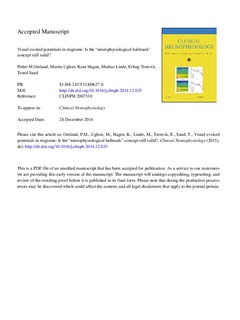| dc.contributor.author | Hagen, Knut | |
| dc.contributor.author | Sand, Trond | |
| dc.contributor.author | Uglem, Martin | |
| dc.contributor.author | Tronvik, Erling Andreas | |
| dc.contributor.author | Linde, Mattias | |
| dc.contributor.author | Omland, Petter Moe | |
| dc.date.accessioned | 2017-01-11T12:24:50Z | |
| dc.date.available | 2017-01-11T12:24:50Z | |
| dc.date.created | 2015-12-21T08:44:16Z | |
| dc.date.issued | 2016 | |
| dc.identifier.citation | Clinical Neurophysiology. 2016, 127 (1), 810-816. | nb_NO |
| dc.identifier.issn | 1388-2457 | |
| dc.identifier.uri | http://hdl.handle.net/11250/2427032 | |
| dc.description.abstract | Objective: Lack of habituation is considered a neurophysiological hallmark of migraine. However, the results of visual evoked potential (VEP) studies have been discrepant, possibly because of different stimulation parameters and lack of blinding. Hence, there is a need for independent confirmation of lack of VEP habituation in migraine. In this blinded study we applied 16’ checks to supplement our previous findings with 8’, 31’, 62’ and 65’ checks.
Methods: VEPs in 41 interictal migraineurs and 30 controls were compared. VEPs were recorded in six blocks of 100 single responses. Linear N70-P100 amplitude change over blocks (habituation slope) was compared with an independent samples Student’s t-test.
Results: Amplitude decline over blocks was observed in both groups. Habituation slope was not significantly different between controls (-0.43 ± 0.54 uV/block) and migraineurs (-0.29 ± 0.35uV/block) (p= 0.33).
Conclusion: VEP habituation with 16’ checks did not differ in migraineurs and controls. This is in agreement with previous findings with other stimulation parameters. It is therefore unlikely that use of different stimulation parameters could explain the discrepant results of previous studies. No studies that applied blinding during recording of VEP have found lack of habituation in migraineurs.
Significance: Lack of VEP habituation cannot be considered a reliable neurophysiological hallmark in migraine. | nb_NO |
| dc.language.iso | eng | nb_NO |
| dc.publisher | Elsevier | nb_NO |
| dc.relation.uri | http://ac.els-cdn.com/S1388245715006276/1-s2.0-S1388245715006276-main.pdf?_tid=9923c822-a7e2-11e5-958c-00000aab0f6c&acdnat=1450702917_bfdfe49b0a530b7cf4be2746474e6214 | |
| dc.title | Visual evoked potentials in migraine: Is the "neurophysiological hallmark" concept still valid? | nb_NO |
| dc.type | Journal article | nb_NO |
| dc.type | Peer reviewed | nb_NO |
| dc.source.pagenumber | 810-816 | nb_NO |
| dc.source.volume | 127 | nb_NO |
| dc.source.journal | Clinical Neurophysiology | nb_NO |
| dc.source.issue | 1 | nb_NO |
| dc.identifier.doi | 10.1016/j.clinph.2014.12.035 | |
| dc.identifier.cristin | 1303038 | |
| dc.description.localcode | (c) 2015 International Federation of Clinical Neurophysiology. Published by Elsevier Ireland Ltd. All rights reserved. This is the authors' accepted and refereed manuscript to the article. Author's post-print is released with a Creative Commons Attribution Non-Commercial No Derivatives License | nb_NO |
| cristin.unitcode | 194,65,30,0 | |
| cristin.unitname | Institutt for nevromedisin | |
| cristin.ispublished | true | |
| cristin.fulltext | postprint | |
| cristin.qualitycode | 2 | |
